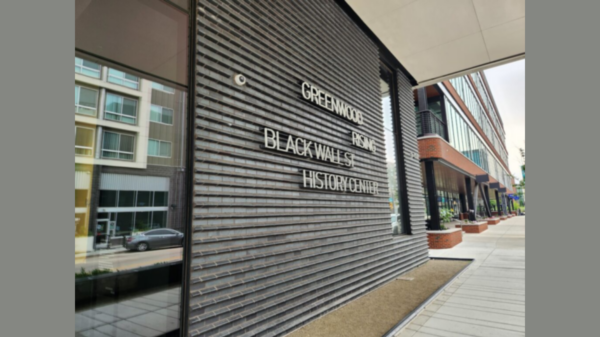Black Wall Street reflects the Story of a Resilient People
Photos and Story
By Sylvia Dunnavant Hines
After a hundred years, the souls of Black Wall Street are rising up to show a resilient people as Tulsa celebrates the centennial of the Greenwood community massacre.
“There is an absolute through line between the past and the present not just for Tulsa but for America in general,” said Hannibal B. Johnson author of Black Wall Street 100: An American City Grapples with Its Historic Racial Trauma. “What hap- pened to Tulsa in terms of the massacre is symbolic of the racial history of America. We know that in the run up for 1921, the year for the incident in Tulsa, we had the summer of 1919. This was called the red summer. Red which was indicative of the blood that was shed from Black people as the result of racial violence in America.”
Last weekend Tulsa comsamemorated the 100th anniversary of the Black Wall Street Massacre which took place May 31 and June 1, 1921, when an angry white mob, which deputized by city officials, attacked Black residents and businesses of the Greenwood District in Tulsa, Oklahoma. They burned the entire 35 square block area killing over 300 people and leaving thousands of people homeless.
“The Black Wall Street Massacre stands out because of the magnitude of the destruction. Greenwood was a well-developed commercial community. There were mom and pop type shops, operations and service providers. The Greenwood District consisted of things like movie theatres, dance halls, hotels, barber shops, beauty salons, pool halls, rooming houses and restaurants.
There was also a group of profession business such: as doctors, dentist, lawyers, and accounts. This was a well-developed Black business community that faced an economic detour. In other words, the reason that the community was successful was because Black folks could not engage with the white dominated community in downtown Tulsa.
They were metaphorically turned away at the gates.They had to create their own economical island within the Greenwood District, which was a 35 square block area, “said Mr. John- son, whose has written four books specifically about the Greenwood District.
According to Mr. Johnson the purpose of the book is designed to help people understand how the Tulsa of 2021 is different from the Tulsa of 1921. The progress that has been made and the progress yet to be made.
Booker T. Washington is credited for labeling the Greenwood District as the Negro Wall Street of America. This area in Tulsa has become prominent because many African Americans, moved to Oklahoma in hopes of gaining a shot at quick economic gains through the mining and oil industries. Over time that term was changed to a more modern more acceptable term Black Wall Street.
“I consider the term Black Wall Street a misnomer. The Greenwood District is not a wall street in terms of banking or investment mecca. It was more of a Black main street. There were mostly small businesses located there,” said Mr. Johnson.
There were damages of over $2 million in claims filed by the 60 businesses and over 1200 home owners who received mass destruction in the Tulsa Massacre. With the current rate of inflation that would be equivalent to about $30 million dollars today. However, experts say the true amount of the value for the destruction is unknown.
“Outside of honoring the victims and descendants, and acknowledging one of the worst racially motivated events on American soil, one of the truly significant reasons why I have been a part of the Commission is the story of Black Wall Street, of entrepreneurship, and the circulation of wealth,” said Clarence Boyd, Steering Committee Member, 1921 Tulsa Race Massacre Centennial Commission. “As a people, that is where our true power lies, and if we can tap into that mindset, the possibilities are truly endless. And Tulsa can be the center of that ecosystem.”
Although the angry white mob of 1921 might have tried to erase the success Black Wall Street, author and historian Johnson feels that it had the opposite effect.
“It is important to under- stand the whole story. The massacre is a chapter in a much larger narrative. The story is not the massacre. The story is the story of the indomitable human spirit. It is a story of some remarkable individuals who created and nurtured a community and resurrected a community after this event happened to them,” added Mr. Johnson. “That is the larger story. This courageous spirit still resides within the community today. One of the things that I have focused on in my work with the 1921 Tulsa Centennial Commission is of course telling the story and acknowledging our history but also cultivating the Black Wall Street mindset and that is the can do spirit.”
Johnson, a graduate of Harvard Law School has also served as an adjunct professor at The University of Tulsa College of Law. He has worked with numerous non-profits and organization in the Tulsa area. His book can be purchased on Amazon.

You must be logged in to post a comment Login